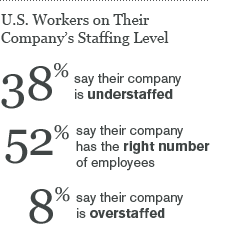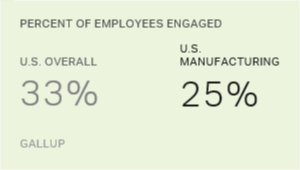PRINCETON, NJ -- Even as millions of Americans are searching for work, 38% of those who do have a job say their company is understaffed, while 52% say their company has about the right number of employees. Few American workers believe their company has too many employees.

The relatively high percentage of workers who say their company is understaffed may partly reflect the residual impact of the economic recession, which sharply changed the employment picture in the United States in recent years. Many companies laid workers off, did not hire new workers to replace those who left, or did both.
Gallup's Job Creation Index -- based on workers' reports of employment at their companies -- was in negative territory for most of 2009 and the first part of 2010, with workers reporting more firing than hiring. The Index is now back in positive territory, but nowhere near as positive as it was throughout the first half of 2008, before the recession's impact was fully felt. Given these trends, it may not be surprising that a sizable percentage of workers who still have jobs at this point feel their company is understaffed.
This year marks the first time Gallup has asked this question, so there is no trend for comparison to previous time frames in which unemployment was much lower and companies were more steadily hiring. It may be that some percentage of workers will always feel their company is understaffed. At the other end of the spectrum, it may also be that some employees are reluctant to admit that their company is overstaffed, even if they perceive that to be the case.
There are few major differences in perceptions of staffing at companies across workers' demographic categories, including gender, age, education, and income. Workers who perceive that their companies are understaffed tend to be slightly less satisfied with their jobs, more stressed, and more likely to feel underpaid -- but it is not possible to determine which of these attitudes may be causing the other.
Implications
Companies may have reached a time of a new normalcy in hiring, attempting to get by with fewer employees than they might have in the past, even as business picks back up. If so, the number of workers who perceive their company to be understaffed may remain at its current level or go even higher in the months and years ahead. On the other hand, the relatively high number of workers who today say their company is understaffed may turn out to be a positive indicator, reflecting a pent-up need for companies to hire more workers, and thus foreshadowing a more positive jobs picture for the future.
Gallup will monitor this measure in the future in order to see whether workers' views of their companies' relative level of staffing move in sync with employment trends.
Survey Methods
Results for this Gallup poll are based on telephone interviews conducted Aug. 5-8, 2010, with a random sample of 499 adults, aged 18 and older, living in the continental U.S. who are employed full or part time, selected using random-digit-dial sampling.
For results based on the total sample of employed adults, one can say with 95% confidence that the maximum margin of sampling error is ±5 percentage points.
Interviews are conducted with respondents on landline telephones (for respondents with a landline telephone) and cellular phones (for respondents who are cell phone-only). Each sample includes a minimum quota of 150 cell phone-only respondents and 850 landline respondents, with additional minimum quotas among landline respondents for gender within region. Landline respondents are chosen at random within each household on the basis of which member had the most recent birthday.
Samples are weighted by gender, age, race, education, region, and phone lines. Demographic weighting targets are based on the March 2009 Current Population Survey figures for the aged 18 and older non-institutionalized population living in continental U.S. telephone households. All reported margins of sampling error include the computed design effects for weighting and sample design.
In addition to sampling error, question wording and practical difficulties in conducting surveys can introduce error or bias into the findings of public opinion polls.
View methodology, full question results, and trend data.
For more details on Gallup's polling methodology, visit www.gallup.com.
